Triumph Engineering Co Ltd was a British motorcycle manufacturing company, based originally in Coventry and then in Meriden. A new company, Triumph Motorcycles Ltd, based in Hinckley, gained the name rights after the end of the company in the 1980s and is now one of the world's major motorcycle manufacturers.

The Triumph Thunderbird is a British motorcycle that was introduced by Triumph in 1949 and produced in many forms until 1966. The name was used three more times for new and distinct Triumph models.

The Triumph Trident and BSA Rocket 3 was a technically advanced, high-performance roadster motorcycle made by Triumph Engineering and BSA from 1968 to 1975, and sold under both the Triumph and BSA marques. Alongside the Honda CB750, and later the Kawasaki triples, it brought a new level of sophistication to street motorcycles, marking the beginning of the superbike era. The Honda CB750 overshadowed the Trident to be remembered as the 'first superbike', in spite of the Triumph Trident actually debuting before the Honda by a few weeks.

The Triumph Bonneville is a standard motorcycle featuring a parallel-twin four-stroke engine and manufactured in three generations over three separate production runs.

Edward Turner was an English motorcycle designer. He was born in Camberwell in the London Borough of Southwark, on the day King Edward VII was proclaimed King. In 1915, Turner had his first ride on a motorcycle, a Light Tourist New Imperial.
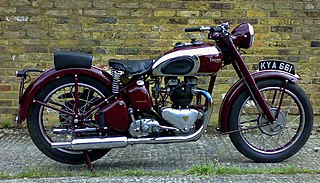
The Speed Twin 5T is a standard motorcycle that was made by Triumph at their Coventry, and later Meriden factories. Edward Turner, Triumph’s Chief Designer and Managing Director, launched the Triumph Speed Twin at the 1937 National Motorcycle Show. It was a 500 cc OHV vertical twin in a lightweight frame and the first truly successful British parallel twin, setting the standard for many twins to follow. After World War II the Speed Twin was responsible for the survival of Triumph, and several major British marques offered a 500 cc twin designed on similar lines to the Speed Twin.

The Triumph Thruxton is a series of British motorcycles with parallel-twin engines and sports styling. The name Thruxton was first applied to a handbuilt machine for endurance racing in the mid 1960s, and later revived in the 2000s.

Triumph Motorcycles Ltd is the largest UK-owned motorcycle manufacturer, established in 1983 by John Bloor after the original company Triumph Engineering went into receivership. The new company, initially called Bonneville Coventry Ltd, continued Triumph's lineage of motorcycle production since 1902. They have major manufacturing facilities in Thailand.
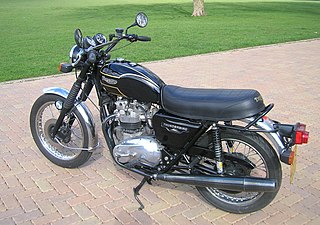
The Triumph TR65 Thunderbird is a motorcycle made by the Triumph worker's co-operative at the Meriden factory from 1981 to 1983. The TR65 was a reintroduction of the Triumph Thunderbird model name first used on the original 6T Thunderbird of 1949. A short stroke model, the Daytona 600 was designed in 1983 but not produced.
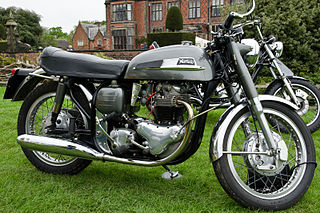
The Dominator is a twin cylinder motorcycle developed by Norton to compete against the Triumph Speed Twin. The original Dominator was designed in 1947 and 1948 by Bert Hopwood, who had been on the Speed Twin design team at Triumph. Available for sale from mid 1949, this design set the pattern for Norton twins for the next 30 years.

The Norton 650SS is a 650 cc (40 cu in) vertical twin motorcycle made by Norton Motorcycle Company from 1962 to 1967. The 650SS was based on the Norton Manxman.
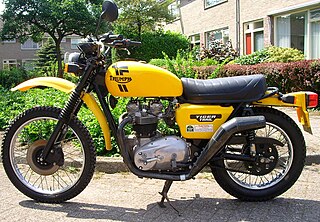
The Triumph Tiger Trail was a motorcycle model manufactured by Triumph Motorcycles at the Meriden factory. The Tiger Trail was made from 1981 to 1982 in both 750 cc (TR7T) and 650 cc (TR65T) capacities, and under 180 examples were built. Emission regulations precluded export to the USA but otherwise the model was available to all Triumph's other markets particularly in many British Commonwealth nations and western Europe.

The BSA A7 was a 500cc motorcycle model range made by Birmingham Small Arms Company (BSA) at their factory in Armoury Road, Small Heath, Birmingham. The range was launched in 1946 using a 495 cc (30.2 cu in) long stroke engine. An improved 497 cc (30.3 cu in) version based on the BSA A10 engine was launched in 1950. The various A7 models continued in production with minor modifications until 1961/2 when they were superseded by the unit-construction A50 model.
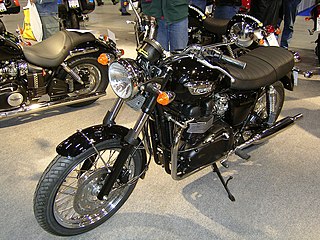
The Triumph Bonneville 790 cc is a British motorcycle that was designed and built in Hinckley, Leicestershire by Triumph Motorcycles Ltd between 2001 and 2007, when the engine size was increased to 865 cc.
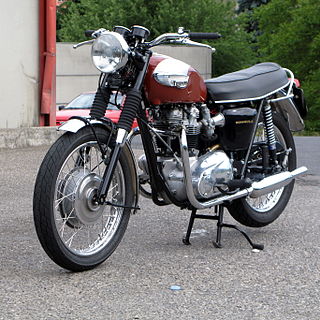
The Triumph Bonneville T120 is a motorcycle originally made by Triumph Engineering from 1959 to 1975. It was the first model of the Bonneville series, which was continued by Triumph Motorcycles Ltd. The T120 was discontinued in favour of the larger 750 cc T140 in the early 1970s.
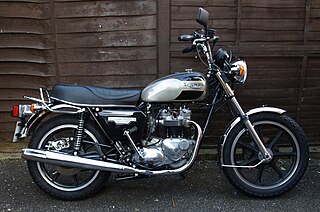
The Triumph Bonneville T140 is a standard motorcycle with a 750 cc (46 cu in) capacity engine that was designed and built by Triumph Engineering at Meriden near Coventry.
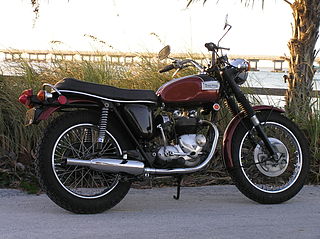
The Triumph Tiger Daytona is a motorcycle made by Triumph from 1967 to 1974.

BSA motorcycles were made by the Birmingham Small Arms Company Limited (BSA), which was a major British industrial combine, a group of businesses manufacturing military and sporting firearms; bicycles; motorcycles; cars; buses and bodies; steel; iron castings; hand, power, and machine tools; coal cleaning and handling plants; sintered metals; and hard chrome process.
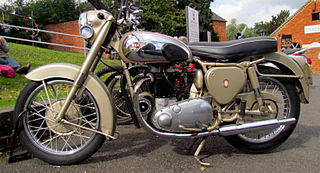
The BSA A10 series was a range of 646 cc (39.4 cu in) air-cooled parallel twin motorcycles designed by Bert Hopwood and produced by Birmingham Small Arms Company at Small Heath, Birmingham from 1950 to 1963. The series was succeeded by the A65 unit construction models.

The Norton Model 99 Dominator was a 600 cc vertical twin motorcycle manufactured by the British Norton Motorcycle Company at their Bracebridge St, Birmingham factory from 1956 to 1962. The 99 was based on the 500 cc Model 88 Dominator with an enlarged engine. The model was superseded by the 650SS.



















